
British Queen Anne Revival architecture, also known as Domestic Revival, is a style of building using red brick, white woodwork, and an eclectic mixture of decorative features, that became popular in the 1870s, both for houses and for larger buildings such as offices, hotels, and town halls. It was popularised by Norman Shaw (1831–1912) and George Devey (1820–1886).
Beginnings
The Queen Anne Revival was to a large extent anticipated by George Frederick Bodley, George Gilbert Scott, Norman Shaw, W. Eden Nesfield, J. J. Stevenson, and Philip Webb in the 1860s; they had used and mixed together brick pediments and pilasters, fan-lights, ribbed chimneys, Flemish or plain gables, hipped roofs, wrought-iron railings, sash windows, outside shutters, asymmetry and even sunflower decorations.
Features
Further information: Architecture of Bedford ParkThe Queen Anne Revival style has, as the architectural historian Mark Girouard writes,
comparatively little to do with Queen Anne. It was the nickname applied to a style which became enormously popular in the 1870s and survived into the early years of this century. 'Queen Anne' came with red brick and white-painted sash windows, with curly pedimented gables and delicate brick panels of sunflowers, swags, or cherubs, with small window panes, steep roofs, and curving bay windows, with wooden balconies and little fancy oriels jutting out where one would least expect them. It was a kind of architectural cocktail, with a little genuine Queen Anne in it, a little Dutch, a little Flemish, a squeeze of Robert Adam, a generous dash of Wren, and a touch of François 1."
All of these features can be seen in houses, large or small, of the later part of the Victorian era.
- Some of the style's decorative features
-
 Red brick and tile-hung detail, "a little genuine Queen Anne"
Red brick and tile-hung detail, "a little genuine Queen Anne"
-
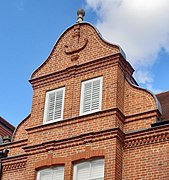 "curly pedimented gables
"curly pedimented gables
... a little Dutch" -
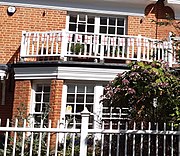 "small window panes, ... bay windows, wooden balconies"
"small window panes, ... bay windows, wooden balconies"
-
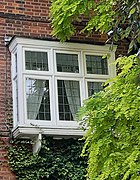 "little fancy oriels"
"little fancy oriels"
-
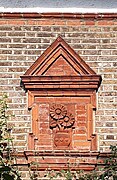 "delicate brick panels of sunflowers"
"delicate brick panels of sunflowers"
Architects
Norman Shaw
Further information: Richard Norman ShawCharacteristic features of Shaw's houses, well seen in the Bedford Park garden suburb in west London alongside the work of other contemporary architects interpreting the Queen Anne Revival style, are red brick, walls hung with tiles, gables of varying shapes, balconies, bay windows, terracotta and rubbed brick decorations, pediments, elaborate chimneys, and balustrades painted white.
Shaw's eclectic designs freely combined Arts & Crafts, Georgian, medieval, Tudor, and Wren styles.
- Norman Shaw
-
 Grim's Dyke, Harrow Weald, 1870–2
Grim's Dyke, Harrow Weald, 1870–2
-
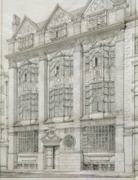 Norman Shaw's design for New Zealand Chambers, Leadenhall Street, 1873
Norman Shaw's design for New Zealand Chambers, Leadenhall Street, 1873
-
 Lowther Lodge, Kensington Gore, now Royal Geographical Society, 1873-5
Lowther Lodge, Kensington Gore, now Royal Geographical Society, 1873-5
-
 Semi-detached houses, Bedford Park, 1878
Semi-detached houses, Bedford Park, 1878
-
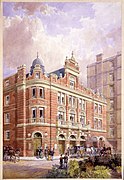 Savoy Theatre, 1881
Savoy Theatre, 1881
-
 Allianz Assurance Building, St. James's Street, 1882–3
Allianz Assurance Building, St. James's Street, 1882–3
J. J. Stevenson
Further information: J. J. StevensonIn 1871–3, the Scottish architect J. J. Stevenson built his widely-imitated Red House on Bayswater Hill; its name may have been a response to William Morris's Red House, Bexleyheath. Both inside and out it was an eclectic mix of styles, with furnishings from different continents and centuries. Outside it was brown brick with red brick dressings; dormer windows with Flemish gables in a flat facade over a cornice; bay windows, and sashes with louvred shutters.
- J. J. Stevenson
-
 The Red House, Bayswater, J. J. Stevenson, 1874
The Red House, Bayswater, J. J. Stevenson, 1874
W. E. Nesfield
Further information: W. E. NesfieldW. E. Nesfield worked in partnership with Shaw from 1866 to 1869, helping to develop the Queen Anne Revival style. Together they examined the architecture of the English countryside, sketching Kent and Sussex's half-timbered farmhouses and tile-hung cottages, and then the structure and ornamentation of houses in country towns, with their red brick, sash windows, plasterwork, pargetting, joinery and rubbed or shaped brick. From this and a measure of George Edmund Street's Gothic Revival, they made their "Old English" style. Gradually adding in their exploration of 17th and 18th century classic architecture, they developed their Queen Anne Revival style.
- W. E. Nesfield
-
 Cottages at Stowford, near Crewe. W. E. Nesfield, 1865
Cottages at Stowford, near Crewe. W. E. Nesfield, 1865
-
 Loughton Hall, 1878
Loughton Hall, 1878
Other architects
- Queen Anne Revival houses by diverse architects
-
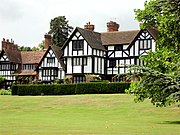 Ascott House, Aylesbury Vale. George Devey, 1874
Ascott House, Aylesbury Vale. George Devey, 1874
-
 Detached house, Bedford Park, London. E. W. Godwin, 1876
Detached house, Bedford Park, London. E. W. Godwin, 1876
-
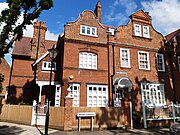 Red brick terrace, Bedford Park. Edward John May, 1880
Red brick terrace, Bedford Park. Edward John May, 1880
-
 Limestone and brick almshouses in Stony Stratford, Milton Keynes. Swinfen Harris, 1892
Limestone and brick almshouses in Stony Stratford, Milton Keynes. Swinfen Harris, 1892
Developments
New World Queen Anne Revival architecture and its derivative the Shingle style are related to the British Queen Anne style but with time became increasingly different from it, and in Girouard's view are "both more adventurous and more exciting."
Reception
Professional

Professional criticism of the style began quickly, with comments such as that in the Building News of 31 May 1872, likely by the church architect J. P. Seddon, that it was "mediaeval, but freely treated, with a good deal of impure classical details, introduced after the fashion of the Queen Anne period, now so much and so foolishly imitated". Other Gothic Revival architects followed suit, though the younger ones were more accepting; E. W. Godwin remarked on the "excellence both of the materials and workmanship" of J. J. Stevenson's Red House. When in 1873 the Royal Academy showed off the designs for George Frederick Bodley's School Board Offices, Edward Robert Robson & Stevenson's Board Schools, and Shaw's New Zealand Chambers, they were found in Girouard's words "clever, no doubt, but also startling and even shocking".
Amateur
The lay press was more relaxed about the new style; The Globe of 13 January 1874 called it a natural response to the more assertive Gothic Revival, while The Saturday Review of 31 July 1875 described its own response as "perfect good humour and equal scepticism", considering the style to be artificially based on an eclectic mix and not at all serious.
References
- ^ Banerjee, Jacqueline (26 May 2017). "Some Features of the Queen Anne/Domestic Revival Family Home". Victorian Web. Retrieved 14 August 2021.
- "Domestic Architecture 1700 to 1960: 7 Late Victorian and Edwardian Architecture - Change". University of the West of England. Retrieved 8 August 2021.
- Girouard 1984, p. 38.
- ^ Girouard 1984, p. 1.
- "Queen Anne and the Domestic Revival". Domestic 3: Suburban and Country Houses Listing Selection Guide. Historic England. December 2017 . pp. 15–17. Retrieved 14 August 2021.
- Anon; Grant, Sandra. "Architecture and architects". The Bedford Park Society. Retrieved 3 August 2021.
- Cherry, Bridget; Pevsner, Nikolaus (1991) . The Buildings of England. London 3: North West. London: Penguin Books. pp. 406–410. ISBN 978-0-14-071048-9. OCLC 24722942.
- Girouard 1984, pp. 160–176.
- Inwood, Stephen (2012). Historic London: An Explorer's Companion. Pan Macmillan. pp. 155–157. ISBN 978-0-230-75252-8.
- ^ Girouard 1984, p. 39.
- Girouard 1984, p. 25.
- Historic England. "Stowford and Magnolia Cottages (1330152)". National Heritage List for England. Retrieved 19 January 2009.
- Girouard 1984, pp. 208–223.
- ^ Girouard 1984, pp. 57–59.
- Girouard 1984, p. 59.
Further reading
- Girouard, Mark (1984) . Sweetness and Light: The Queen Anne Movement, 1860–1900. Yale University Press. ISBN 978-0-300-03068-6. The primary survey of the movement.
| Chiswick | |||||||||||||||
|---|---|---|---|---|---|---|---|---|---|---|---|---|---|---|---|
| Ealing |
|  | |||||||||||||
| Hounslow |
| ||||||||||||||
| Transport | |||||||||||||||
| Other |
| ||||||||||||||